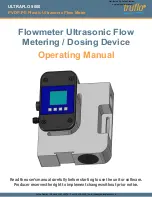
60
Controlling the UDMR with MIDI signals
Definition of MIDI/ What can be
controlled with MIDI signals?
MIDI stands for Musical Instrument Digital Interface – a
common protocol used around the world for exchanging
performance information between electronic musical
instruments and computers. As long as devices support the
MIDI protocol, it is possible to connect them with a MIDI cable
to transmit performance information and control device
operations and settings.
The UDMR can perform the following operations using MIDI
signals.
Recording and playback of MIDI signals from external
MIDI devices in the same way as DMX phrases
Starting phrase playback using MIDI signals from external
MIDI devices.
Remote and synchronized operation using MMC/ MTC
signals from external MIDI devices.
Starting and stopping phrase playback by receiving MMC
signals (p.66).
Synchronizing phrase playback with video devices using a
combination of MMC and MTC signals (p.69).
Please also refer to 'MIDI Implementation' on page 99 for the
specifications of the MIDI messages which can be transmitted
and received by the UDMR.
Key MIDI terms
MIDI message
A MIDI signal message required for MIDI audio source
performances. Examples include system exclusive
messages, which consist of note data for enabling and
disabling audio as well as model-specific data.
Note number
Number data assigned to electronic instrument
keyboards (note names). Numbers are assigned in
semitone units for each key ranging from 0 to 127, with
the center C (C4) designated as note number 60. The
UDMR uses note numbers for designating phrases.
Note On
Data notifying that the key of an electronic instrument
has been struck.
Note Off
Data notifying that the key of an electronic instrument
has been released.
Program Change
Data for changing the tone of an electronic instrument.
The UDMR uses this data to change phrase sets in units
of 100.
















































